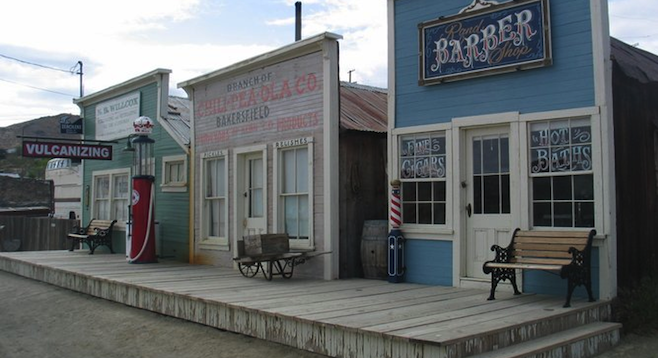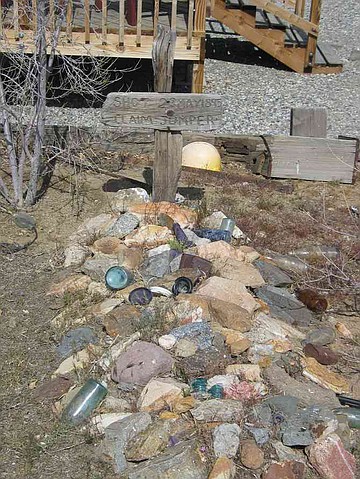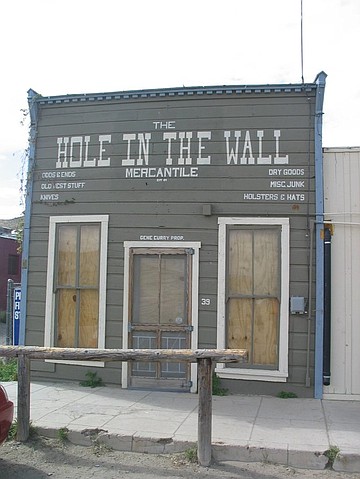 Facebook
Facebook
 X
X
 Instagram
Instagram
 TikTok
TikTok
 Youtube
Youtube

If you're a fan of Westerns, at one time or another you've seen one filmed in Randsburg, where the spirit of the old West is alive and thriving just three hours' drive from San Diego.
One of several ghost towns that dot the Mojave Desert, Randsburg sits just off Highway 395 on a plateau at 3,500 feet.
If ever the saying "there's gold in them thar hills" applied, it is appropriate for Randsburg. It was the discovery of that precious yellow that gave birth to the town in 1896 when John Singleton, F.M. Mooers and Charlie Burcham filed a claim they called "The Rand."
Within a few months, a saloon, barber shop, general store and even an opera house had sprung up and were known locally as "Rand Camp." By 1897 Randsburg was a boomtown of almost 4,000 people. The same year, three separate fires destroyed most of the original town, but some of the $60 million dollars in gold profits quickly rebuilt it. The Yellow Aster mine alone had taken $25 million dollars worth of gold at the day’s price of $20 an ounce.
Over 110 years later, the Rand Mining Company still operates 24 hours a day and employs about 80 workers. None of them would confirm the rumored 300 pounds of gold taken from this mine each month.

As local gold petered out, so did the population, but not the town’s spirit. Many hardy souls stayed on, and today 300 of their descendants still occupy their forbearers' homes as full-time residents and take pride in sharing their colorful past with visitors, living in houses as eclectic as their owners. One house is made entirely from garage doors; another only from windows that has trees made from cast-off soda bottles in the front yard. There are more than a few outhouses.
Several gravestones with colorful epitaphs dot the town, announcing the resting place of robbers and claim jumpers – but these were put here to entertain tourists and are not authentic.
Butte Street is the main drag and home to the White House and the Joint, two authentic saloons complete with boot rails and spittoons. No liquor is served, but you can still get a shot of spiced sarsaparilla. The barber shop with its traditional striped pole advertises baths and cigars, and the opera house still puts on several extravaganzas annually featuring the "Gold Dust Players."
I followed the hitching posts that line the wooden boardwalk to discover a wonderful little natural history museum manned by town volunteers in period costume eager to spend an afternoon sharing local lore with visitors.
On the edge of town, a mule tethered to a hitching post tried to lick my camera, and I passed a weathered old tortoise out for a leisurely stroll. These desert tanks are a local favorite and claim protected status from the locals, who make a point of telling visitors that tortoises do not handle stress easily, as it causes them to pass water, making them vulnerable to the desert heat. Randsburgians love their tortoises.
There's a good feeling as you walk through this town – a feeling of local pride, and that you're welcome here. You can see it in a day, but I recommend a weekend to take in all the history.

What I liked best about Randsburg is the fact that its residents have gone to great lengths to keep the town exactly as it was a century ago. The wall outside the Rand Mining Company sports a faded sign noting "Everything for Blasting" and "Explosives, caps and fuses." The Hole in the Wall Mercantile Store offers "Knives, holsters, odds n' ends and Junk" while the local post office sign proclaims it's the "End of the trail" over a cow's skull greeting visitors at the front door.
If you're in the mood for an authentic story, there's Cowboy Bob’s curio shop, filled with such treasures as stuffed rattlesnakes and Lucite paperweight globes with scorpions inside. The owner likes nothing more than to spin yarns for tourists about the good old days and does not care if you pass the entire day without buying a thing. In fact, he talked me out of buying a lamp made from deer antlers, insisting it was a piece of junk. The wall behind his desk is covered with newspaper clippings of movies and television shows shot there on location.
Randsburg is so small you might miss it as you drive by on 395, but it's one of those little gems that only reveal themselves to those who venture off the beaten path. It's close enough to Los Angeles for a day trip, yet far enough away to take a visitor back more than a century.
If you go. Randsburg is in the heart of the Mojave Desert, northwest of Mojave City on Highway 395. It's midway between Boron to the south and Ridgecrest to the north, about a 2½ hour drive from Los Angeles. The quickest route from L.A. is to take I-5 (Golden State Freeway) north to Highway 14 (Antelope Valley Freeway), then north to Mojave. About 20 miles north of Mojave there's a sign for the turn to Randsburg and Johannesburg off of Highway 14.
There are no services north of Mojave until you hit Ridgecrest, so make sure to top off the gas tank before entering the high desert.
Hotels and services. There are two local hotel in Randsburg: The Randsburg Inn is a nice one. It only has three rooms, and reservations are required. The Cottage Hotel is also reservations-only and offers cabin rentals.
There are also numerous hotels, restaurants and visitor services available in Mojave and Ridgecrest.


If you're a fan of Westerns, at one time or another you've seen one filmed in Randsburg, where the spirit of the old West is alive and thriving just three hours' drive from San Diego.
One of several ghost towns that dot the Mojave Desert, Randsburg sits just off Highway 395 on a plateau at 3,500 feet.
If ever the saying "there's gold in them thar hills" applied, it is appropriate for Randsburg. It was the discovery of that precious yellow that gave birth to the town in 1896 when John Singleton, F.M. Mooers and Charlie Burcham filed a claim they called "The Rand."
Within a few months, a saloon, barber shop, general store and even an opera house had sprung up and were known locally as "Rand Camp." By 1897 Randsburg was a boomtown of almost 4,000 people. The same year, three separate fires destroyed most of the original town, but some of the $60 million dollars in gold profits quickly rebuilt it. The Yellow Aster mine alone had taken $25 million dollars worth of gold at the day’s price of $20 an ounce.
Over 110 years later, the Rand Mining Company still operates 24 hours a day and employs about 80 workers. None of them would confirm the rumored 300 pounds of gold taken from this mine each month.

As local gold petered out, so did the population, but not the town’s spirit. Many hardy souls stayed on, and today 300 of their descendants still occupy their forbearers' homes as full-time residents and take pride in sharing their colorful past with visitors, living in houses as eclectic as their owners. One house is made entirely from garage doors; another only from windows that has trees made from cast-off soda bottles in the front yard. There are more than a few outhouses.
Several gravestones with colorful epitaphs dot the town, announcing the resting place of robbers and claim jumpers – but these were put here to entertain tourists and are not authentic.
Butte Street is the main drag and home to the White House and the Joint, two authentic saloons complete with boot rails and spittoons. No liquor is served, but you can still get a shot of spiced sarsaparilla. The barber shop with its traditional striped pole advertises baths and cigars, and the opera house still puts on several extravaganzas annually featuring the "Gold Dust Players."
I followed the hitching posts that line the wooden boardwalk to discover a wonderful little natural history museum manned by town volunteers in period costume eager to spend an afternoon sharing local lore with visitors.
On the edge of town, a mule tethered to a hitching post tried to lick my camera, and I passed a weathered old tortoise out for a leisurely stroll. These desert tanks are a local favorite and claim protected status from the locals, who make a point of telling visitors that tortoises do not handle stress easily, as it causes them to pass water, making them vulnerable to the desert heat. Randsburgians love their tortoises.
There's a good feeling as you walk through this town – a feeling of local pride, and that you're welcome here. You can see it in a day, but I recommend a weekend to take in all the history.

What I liked best about Randsburg is the fact that its residents have gone to great lengths to keep the town exactly as it was a century ago. The wall outside the Rand Mining Company sports a faded sign noting "Everything for Blasting" and "Explosives, caps and fuses." The Hole in the Wall Mercantile Store offers "Knives, holsters, odds n' ends and Junk" while the local post office sign proclaims it's the "End of the trail" over a cow's skull greeting visitors at the front door.
If you're in the mood for an authentic story, there's Cowboy Bob’s curio shop, filled with such treasures as stuffed rattlesnakes and Lucite paperweight globes with scorpions inside. The owner likes nothing more than to spin yarns for tourists about the good old days and does not care if you pass the entire day without buying a thing. In fact, he talked me out of buying a lamp made from deer antlers, insisting it was a piece of junk. The wall behind his desk is covered with newspaper clippings of movies and television shows shot there on location.
Randsburg is so small you might miss it as you drive by on 395, but it's one of those little gems that only reveal themselves to those who venture off the beaten path. It's close enough to Los Angeles for a day trip, yet far enough away to take a visitor back more than a century.
If you go. Randsburg is in the heart of the Mojave Desert, northwest of Mojave City on Highway 395. It's midway between Boron to the south and Ridgecrest to the north, about a 2½ hour drive from Los Angeles. The quickest route from L.A. is to take I-5 (Golden State Freeway) north to Highway 14 (Antelope Valley Freeway), then north to Mojave. About 20 miles north of Mojave there's a sign for the turn to Randsburg and Johannesburg off of Highway 14.
There are no services north of Mojave until you hit Ridgecrest, so make sure to top off the gas tank before entering the high desert.
Hotels and services. There are two local hotel in Randsburg: The Randsburg Inn is a nice one. It only has three rooms, and reservations are required. The Cottage Hotel is also reservations-only and offers cabin rentals.
There are also numerous hotels, restaurants and visitor services available in Mojave and Ridgecrest.
Comments